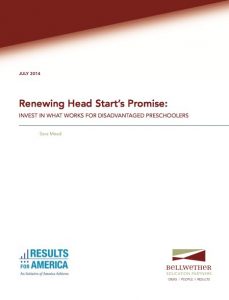 Americans increasingly recognize what research shows—high-quality preschool programs have the potential to improve children’s school readiness, narrow achievement gaps,
Americans increasingly recognize what research shows—high-quality preschool programs have the potential to improve children’s school readiness, narrow achievement gaps,
and put children on track to become successful adults. In response, policymakers at the national, state, and local levels—from Alabama to New York City, to the White House— are calling for and making new investments in preschool programs. But too often Head Start is ignored in these efforts.
As our nation’s largest preschool program—and the only one exclusively focused on
the poorest children—Head Start plays a critical role in our nation’s early earning and development system, and it will continue to do so. As policymakers seek to extend the benefits of quality preschool to more children, improving Head Start must be part of these efforts.
Despite ongoing debate about Head Start’s effectiveness, the best available research suggests that Head Start programs improve children’s kindergarten readiness at school entry; that participating in Head Start has significant long-term benefits compared with no preschool at all; and that some Head Start programs are producing even greater results. At the same time, the results suggest that Head Start programs are, on average, not matching the results of the highest-performing pre-k programs. If all Head Start programs matched the results produced by the best pre-k programs, we could dramatically improve outcomes for our nation’s poorest youngsters.
Since Head Start’s last reauthorization, in 2007, the Department of Health and Human Services, which oversees Head Start, has implemented significant reforms that are improving the program:
- Head Start now uses the Classroom Assessment Scoring System, a research-based observation system, to measure the quality of teaching in Head Start classrooms and drive improvements in instruction.
- Through the new “designation renewal” system, the Office of Head Start has required low-performing grantees to compete for their grants, terminated the grants of weak grantees, and replaced them with higher-quality providers.These changes represent real progress, but additional change is still needed. Head Start continues to lack clear, comprehensive goals for program performance; to overemphasize compliance; to require programs to do too many different things; and to pay too little attention to curriculum. Head Start’s unique federal-to-local structure creates challenges in coordinating with state-run pre-k programs, efforts to improve child care quality, and the K-12 public school system. In addition, the designation renewal system can be improved to maximize its potential to drive quality improvement and attract high-quality new providers to Head Start.To address these challenges and enable Head Start to better serve children and families, this paper recommends the following steps:Maximize the effectiveness of designation renewal:
- Increase transparency in Head Start monitoring and designation renewal processes.
- Prioritize performance and innovation in the designation renewal process.
- Encourage new providers.
- Improve planning for transition.
Set clear goals and measure program performance:
- Establish clear metrics of program performance at the grantee level.
- Expand analysis of Head Start performance data.
- Make monitoring reports transparent and easy to access.Increase flexibility to innovate:
- Revise the Head Start Performance Standards to focus less on compliance and more on improving outcomes for children and families.
- Allow grantees to apply for waivers.
- Rethink Head Start’s matching requirement.Carefully explore options to expand the state role in Head Start while protecting federal investments and comprehensive services for Head Start children. By strengthening Head Start we can improve both the school readiness and long-term life outcomes for our nation’s most disadvantaged youngsters.